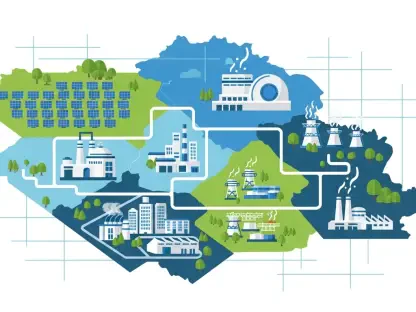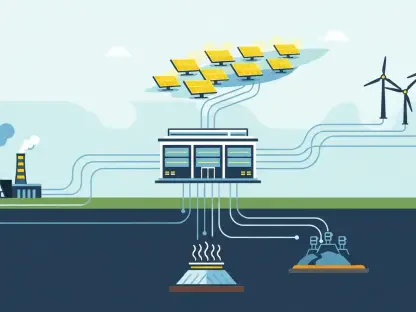Welcome to an insightful conversation with Christopher Hailstone, a seasoned expert in energy management, renewable energy, and electricity delivery. With a deep understanding of grid reliability and security, Christopher provides unparalleled insights into the challenges and opportunities facing regional transmission organizations like PJM Interconnection. Today, we dive into PJM’s urgent push to integrate massive loads from data centers through their Critical Issue Fast Path initiative, exploring the implications for grid stability, resource adequacy, and the future of power delivery in a rapidly changing energy landscape.
What inspired PJM Interconnection to launch the Critical Issue Fast Path initiative, and what’s the core purpose behind this effort?
The Critical Issue Fast Path initiative is really about addressing an unprecedented challenge in the energy sector. PJM, which manages the grid across 13 states and D.C., is seeing an explosive growth in demand, primarily from data centers. The core purpose is to create a framework for interconnecting these large loads quickly without compromising grid reliability. They’re racing against time to get a proposal to the Federal Energy Regulatory Commission by year-end, so it’s in place for the 2028/2029 capacity auction. It’s a proactive move to ensure the system doesn’t buckle under this new pressure.
Why are data centers becoming such a significant focus for PJM at this moment?
Data centers are a game-changer for PJM because of their sheer energy appetite. The latest forecasts predict a staggering 32 GW increase in peak load by 2030, and almost all of that is tied to data centers. That’s on top of last year’s peak of 153 GW. A key area driving this is northern Virginia, often called Data Center Alley, which is the world’s largest hub with nearly 250 centers and more under construction. This concentration of demand in one region creates unique challenges for balancing the grid.
How is this sudden surge in demand from data centers impacting PJM’s operations and market dynamics?
The surge is putting immense strain on PJM’s system. We’ve already got tight supply-demand conditions, and that’s led to record-breaking price spikes in the last two capacity auctions. These price jumps signal how much pressure the system is under. The demand growth is clear, but there’s a lot of uncertainty about how fast and how big it’ll get, which makes planning incredibly tough. It’s a wake-up call that the grid needs to adapt—and fast.
What specific obstacles are power plant developers facing as they try to meet this rising demand?
Developers are hitting a wall on multiple fronts. Siting and permitting are huge hurdles—finding suitable locations and getting approvals is a slow, often contentious process. Then there are supply chain delays; getting the equipment and materials needed for new plants or upgrades is taking longer than ever. These challenges mean that even if there’s a will to build new capacity, the timeline to actually deliver power is stretched, which exacerbates the supply crunch PJM is dealing with.
Can you break down the four key areas PJM’s board is targeting with this fast-track initiative?
Absolutely. First, there’s resource adequacy, which is about ensuring the system can meet demand at all times. Second is reliability criteria—setting standards to make sure these large loads don’t destabilize the grid. Third, they’re looking at interconnection rules, potentially revising how data centers and similar projects tie into the system. Lastly, coordination is critical—PJM needs to align with states, large load customers, and other stakeholders to make this work. Each of these areas is a piece of the puzzle to manage rapid growth responsibly.
What kinds of solutions is PJM exploring to integrate these large loads without sacrificing grid reliability?
PJM is considering a range of tools to balance this demand. Demand response programs, where large users cut back during peak times, are on the table as a way to manage load spikes. There’s also talk of encouraging large load customers, like data centers, to bring their own power supplies—think on-site generation or dedicated resources. These solutions aim to ease the burden on the grid while still allowing for growth, but they’ll require innovative policies and incentives to implement effectively.
How is PJM involving stakeholders in shaping this initiative, and what role do these engagements play?
Stakeholder engagement is a cornerstone of this process. PJM kicked things off with a workshop on May 9 to explore large load challenges, which helped frame the fast-track initiative. There’s another key workshop on August 18 where PJM will present an initial proposal, and stakeholders can weigh in on the scope and direction. These sessions are vital for gathering diverse perspectives—from utilities to data center operators—and ensuring the final rules are practical and broadly supported.
Looking ahead, what’s your forecast for how PJM’s efforts to integrate large loads like data centers will shape the future of grid management?
I think we’re at a turning point for grid management. If PJM can pull off this fast-track initiative successfully, it could set a precedent for other regions facing similar demand surges. We’ll likely see more emphasis on flexible tools like demand response and customer-supplied power, alongside tighter coordination between grid operators and large users. But the uncertainty around growth trajectories means adaptability will be key. Over the next decade, I expect grid planning to become far more dynamic, with technology and policy evolving hand-in-hand to keep the lights on.









